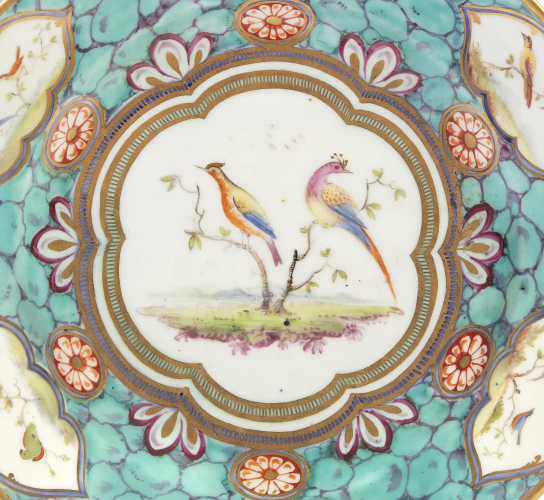Thomas Pardoe was one of the most versatile British painters of pottery and porcelain in the late 18th and early 19th century. From humble beginnings in Derby and through to Swansea, Bristol, and finally Nantgarw in Wales, his decorative schemes on porcelain have been highly sought-after by collectors for generations.
Born in the parish of St Alkmund in Derby, Pardoe was apprenticed to the local porcelain works at the age of 15, and by age 20 had moved to Swansea as a skilled artisan by request of George Haynes, owner of Cambrian Pottery. Between 1802 and 1804 Pardoe was acting manager and chief painter. By 1800 Pardoe had developed a mature style with an immediacy and liveliness that was unusual at the time, embracing botanical decoration, landscapes with figures, birds and animals, flowers and fruit, shells, and east-Asian-influenced styles. Pardoe was indebted to illustrations in William Curtis’ Botanical Magazine, which he copied in watercolour with added incidental details from sources such as Robert Sayer’s The Ladies Amusement. While at Cambrian Pottery, Pardoe began a long and fulfilling partnership with William Weston Young, occasionally collaborating as decorators between 1803-06. Although this period was not the most commercial successful, it represents the high point for Pardoe’s decoration at Cambrian Pottery.
Around 1809 Pardoe moved to Bristol, where he is recorded as having a decorating business. As the major economic centre for South Wales and the West Country, Bristol was an obvious move for Pardoe to gain further commissions and widen his influence, and his business grew between 1812-16. A self-portrait by Pardoe shows how he presented himself as a prosperous and respectable artist and craftsman. In Bristol Pardoe decorated porcelain from Coalport and Staffordshire, and won commissions from Bristol’s leading families and Welsh gentry. Pardoe branched out into painting window glass for churches and private houses (though none of his work survives) and instructing well-to-do women in the art of painting china and velvet.
While in Bristol, Pardoe acted as go-between in the development of a new venture of porcelain manufacture at Nantgarw, aiming to manufacture the finest porcelain available for the English market. Pardoe’s father William had painted at Derby with the prime mover behind Nantgarw, William Billingsley, and it is likely that Pardoe brought together Billingsley and his old friend William Weston Young, who financially supported the establishment of the porcelain works at Nantgarw. However, by 1820 Billingsley had departed Nantgarw, and in 1821 Pardoe was invited by Young to work with him and decorate the large stock of porcelain that remained. Pardoe maintained his Bristol business while at Nantgarw, visiting weekly and even decorating Nantgarw china at his Bristol business.
It has been commented that Pardoe was able to paint anything required of him, from elaborate flowers and fruits, birds and landscapes, to simple geometric designs and patterned borders. Equally he was able to work at great speed, and has been credited with decorating more pottery and porcelain than any other contemporaneous artist of his day. Pardoe’s Nantgarw painting was based on his standard repertoire, including Japanese-influenced ‘Imari’ styles, Chinese-influenced ‘famille rose’ styles, botanical decoration, naturalistic flower groups, and caillouté or ‘pebbled’ gilding. He also developed a catalogue of genre subjects and observations of everyday life, and painted a number of local views such as waterfalls in the Vale of Neath and the famous Pontypridd bridge just a few miles from Nantgarw. Pardoe’s painting at Nantgarw was among his very finest, a reflection of his great admiration for the factory and the culmination of some thirty years of painting experience.
Despite Pardoe’s efforts, the factory at Nantgarw was declared bankrupt in October 1822, and Pardoe took on the responsibility of decorating the remaining stock, possibly on behalf of Young’s creditors, but more likely to become sole proprietor of the china works. Pardoe died at Nantgarw on 23rd July 1823 and was buried in the churchyard at Eglwysilan on the hillside above Nantgarw. In about 1833 Pardoe’s son William Henry re-opened the Nantgarw site as a pottery and clay pipe works, and his descendants ran the Nantgarw factory until its closure in 1920.
